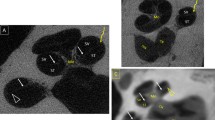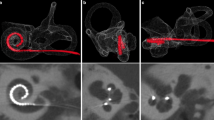Abstract
Purpose
The aim of this study was to illustrate the different imaging features of middle and inner ear implants, brainstem implants and inferior colliculus implants.
Materials and methods
We retrospectively reviewed the computed tomography (CT) images of 468 patients with congenital or acquired transmissive or neurosensory hearing loss who underwent surgery. The implants examined were: 22 Vibrant Soundbridge implants, 5 at the long limb of the incus and 17 at the round window, 350 cochlear implants, 95 brainstem implants and 1 implant at the inferior colliculus. All patients underwent a postoperative CT scan (single or multislice scanner) and/or a Dentomaxillofacial cone-beam CT scan (CBCT) (axial and multiplanar reconstruction), and/or a plain-film radiography to visualise the correct position of the implant.
Results
The CBCT scan depicts Vibrant site of implant better than plain-film radiography, with a lower radiation dose compared to CT. For cochlear implants, a single plain radiograph in the Stenvers projection can directly visualise the electrodes in the cochlea. All patients with brainstem or inferior colliculus implants underwent postoperative CT to exclude complications and the assess correct implantation, but the follow-up of these implants can be performed by plain radiography alone.
Conclusions
CT and CBCT scans are reliable and relatively fast methods for precisely determining the location of middle ear implants. CBCT is preferable to CT because of the lower radiation dose administered; a single plain-film radiograph is enough to visualise and follow-up cochlear, brainstem and inferior colliculus implants.
Riassunto
Obiettivo
Illustrare le caratteristiche delle diverse tecniche impiegate nell’imaging degli impianti protesici all’orecchio medio e interno, degli impianti al tronco encefalico ed al collicolo inferiore.
Materiali e metodi
Sono state analizzate retrospettivamente le immagini di tomografia computerizzata (TC) di 468 pazienti affetti da ipoacusia congenita o acquisita trasmissiva o neurosensoriale, sottoposti a intervento chirurgico protesico. I modelli di impianto esaminati sono stati: 22 Vibrant, di cui 5 all’apofisi lunga dell’incudine e 17 alla finestra rotonda, 350 impianti cocleari, 95 impianti al tronco e 1 al collicolo inferiore. Tutti i pazienti hanno eseguito nel postoperatorio una indagine TC (scanner a singolo o multistrato) e/o una TC dentale a raggio conico (TCD) (ricostruzioni assiali e multiplanari), e/o una radiografia convenzionale, al fine di visualizzare la corretta posizione dell’impianto.
Risultati
Le scansioni TCD hanno identificato meglio il sito di impianto del Vibrant rispetto alla radiografia convenzionale: la visualizzazione è uguale a quella della TC ma la dose radiante è inferiore. Per gli impianti cocleari, la radiografia in proiezione secondo Stenvers ha consentito di visualizzare direttamente gli elettrodi nella coclea in tutti i casi. Tutti i pazienti con impianto al tronco o al collicolo inferiore sono stati sottoposti a indagine TC nell’immediato postoperatorio al fine di escludere complicanze e per stimare il corretto posizionamento della protesi, ma il follow-up di queste ultime può essere eseguito con la sola radiografia del cranio.
Conclusioni
La TC e la TCD si sono rivelate metodiche affidabili e relativamente veloci per determinare con precisione la posizione dell’impianto all’orecchio medio. La TCD è preferibile alla TC per la minor dose radiante somministrata; la sola radiografia del cranio, è sufficiente per visualizzare gli impianti cocleari, al tronco ed al collicolo inferiore, e per effettuarne il follow-up.
Similar content being viewed by others
References/Bibliografia
Lapointe A, Viamonte C, Morris CM et al (2006) Central nervous system findings by magnetic resonance in children with profound sensorineural hearing loss. Int J Pediatr Otorhinolaryngol 70:863–868
Palmieri A, Ettorre GC (2004) Cochlear and vestibular aqueducts. Radiol Med 107:541–555
Cerini R, Faccioli N, Cicconi D et al (2006) Role of CT and MRI in the preoperative evaluation of auditory brainstem implantation in patients with congenital inner ear pathology. Radiol Med 111:978–988
Suzuki J, Kodera K, Yanagihara N (1985) Middle ear implant for humans. Acta Otolaryngol 99:313–317
Needham AG, Jiang D, Bibas A (2005) The effects of mass loading the ossicles with a floating mass transducer on middle ear transfer function. Otol Neurotol 26:218–224
Zwisloslocki JJ (1986) Analysis of cochlear mechanics. Hear Res 22:155–169
Merchant SN, Ravicz ME, Puria S et al (1997) Analysis of middle ear mechanics and application to diseased and reconstructed ears. Am J Otol 18:139–154
Spindel JH (2002) Middle ear implantable hearing devices. Am J Audiol 11:104–113
Stenfelt S, Hato N, Goode RL (2004) Round window membrane motion with air conduction and bone conduction stimulation. Hear Res 198:10–24
Stenfelt S, Hato N, Goode RL (2004) Fluid volume displacement at oval and round windows with air and bone conduction stimulation. J Acoust Soc Am 115:797–812
Marsot-Dupuch K, Meyer B (2001) Cochlear implant assessment: imaging issues. Eur J Radiol 40:119–132
Nadol Jr JB (1997) Patterns of neural degeneration in the human cochlea and auditory nerve: implications for cochlear implantation. Otolaryngol Head Neck Surg 117:220–228
Colletti V, Fiorino F, Carner M et al (2000) Retrosigmoid approach for auditory brainstem implantation. Am J Otol 21:826–836
Colletti V, Fiorino F, Carner M et al (2002) Auditory brainstem implantation: The University of Verona experience. Otolaryngol Head Neck Surg 127:84–96
Colletti V, Carner M, Miorelli V et al (2005) Auditory brainstem implant (ABI): new frontiers in adults and children. Otolaryngol Head Neck Surg 133:126–138
Ramsden RT (2002) Cochlear implants and brain stem implants. Br Med Bull 63:183–193
Waring MD (1995) Auditory brainstem responses evoked by electrical stimulation of the cochlear nucleus in human subjects. Electroencephalogr Clin Neurophysiol 96:338–347
Cohen LT, Xu J, Xu SA et al (1996) Improved and simplified methods for specifying positions of the electrode bands of a cochlear implant array. Am J Otol 17:859–865
Marsh MA, Xu J, Blamey PJ et al (1993) Radiologic evaluation of multichannel intracochlear implant insertion depth. Am J Otol 14:386–391
Shpizner BA, Holliday RA, Roland JT et al (1995) Postoperative imaging of the multichannel cochlear implant. Am J Neuroradiol 16:1517–1524
Lawson JT, Cranley K, Toner JG (1998) Digital imaging: a valuable technique for the postoperative assessment of cochlear implantation. Eur Radiol 8:951–954
Kubo T, Matsuura S, Iwaki T (2005) Complications of cochlear implant surgery. Op Tech Otorhinolaryngol 16:154–158
Lo WWM (1998) Imaging of cochlear and auditory brainstem implantation. Am J Neuroradiol 19:1147–1154
Wackym PA, Runge-Samuelson CL, Firszt JB (2005) Auditory brainstem implantation. Op Tech Otorhinolaryngol 16:159–163
Dalchow CV, Weber AL, Bien S et al (2006) Value of digital volume tomography in patients with conductive hearing loss. Eur Arch Otorhinolaryngol 263:92–99
Dalchow CV, Weber AL, Yanagihara N (2006) Digital volume tomography: radiologic examinations of the temporal bone. AJR Am J Roentgenol 186:416–423
Robinson S, Suomalainen A, Kortesniemi M (2005) μ-CT. Eur J Radiol 56:185–191
Mozzo P, Procacci C, Tacconi A et al (1998) A new volumetric CT machine for dental imaging based on the cone-beam technique: preliminary results. Eur Radiol 8:1558–1564
Author information
Authors and Affiliations
Corresponding author
Rights and permissions
About this article
Cite this article
Cerini, R., Faccioli, N., Barillari, M. et al. Bionic ear imaging. Radiol med 113, 265–277 (2008). https://doi.org/10.1007/s11547-008-0244-y
Received:
Accepted:
Published:
Issue Date:
DOI: https://doi.org/10.1007/s11547-008-0244-y




